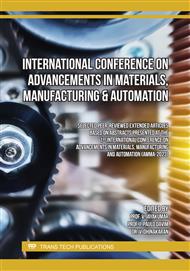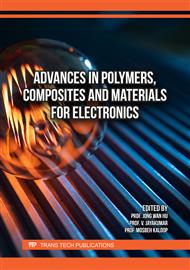[1]
Amiandamhen SO, Meincken M, Tyhoda L (2020) Natural Fibre Modification and Its Influence on Fibre-matrix Interfacial Properties in Biocomposite Materials. Fibers Polym 21:677–689
DOI: 10.1007/s12221-020-9362-5
Google Scholar
[2]
Asrofi M, Abral H, Kasim A, Pratoto A (2017) Characterization of the microfibrillated cellulose from water hyacinth pulp after alkali treatment and wet blending. IOP Conf Ser Mater Sci Eng 204:
DOI: 10.1088/1757-899X/204/1/012018
Google Scholar
[3]
Chonsakorn S, Srivorradatpaisan S (2018) Effects of different extraction methods on some properties of water hyacinth fiber. J Nat Fibers 00:1–11
DOI: 10.1080/15440478.2018.1448316
Google Scholar
[4]
Du Y, Wu Q, Kong D, Shi Y, Huang X, Luo D, Chen Z, Xiao T, Leung JYS (2020) Accumulation and translocation of heavy metals in water hyacinth: Maximising the use of green resources to remediate sites impacted by e-waste recycling activities. Ecol Indic 115:106384
DOI: 10.1016/j.ecolind.2020.106384
Google Scholar
[5]
Hajar U, Wardoyo AYP, Masruroh (2019) Developing and characterization of an ultrafine filter made of banana leaf and water hyacinth to reduce motorcycle emission. Appl Ecol Environ Res 17:1959–1965
DOI: 10.15666/aeer/1702_19591965
Google Scholar
[6]
Indulekha VP, Thomas CG, Anil KS (2019) Utilization of water hyacinth as livestock feed by ensiling with additives. Indian J Weed Sci 51:67
DOI: 10.5958/0974-8164.2019.00014.5
Google Scholar
[7]
Liu J, Tang Z, Wang C, Wu K, Song Y, Wang X, Zhang Z, Zhao X, Yang B, Piao M, Yin F, Zhang W (2021) Novel technique for sustainable utilisation of water hyacinth using EGSB and MCSTR: Control overgrowth, energy recovery, and microbial metabolic mechanism. Renew Energy 163:1701–1710
DOI: 10.1016/j.renene.2020.10.093
Google Scholar
[8]
Lu X, Liu L, Fan R, Luo J, Yan S, Rengel Z, Zhang Z (2017) Dynamics of copper and tetracyclines during composting of water hyacinth biomass amended with peat or pig manure. Environ Sci Pollut Res 24:23584–23597
DOI: 10.1007/s11356-017-9979-0
Google Scholar
[9]
Moghanm FS, El-Banna A, El-Esawi MA, Abdel-Daim MM, Mosa A, Abdelaal KAA (2020) Genotoxic and anatomical deteriorations associated with potentially toxic elements accumulation in water hyacinth grown in drainage water resources. Sustain 12:1–16
DOI: 10.3390/su12052147
Google Scholar
[10]
Rahman MA (2018) Pyrolysis of water hyacinth in a fixed bed reactor: Parametric effects on product distribution, characterization and syngas evolutionary behavior. Waste Manag 80:310–318
DOI: 10.1016/j.wasman.2018.09.028
Google Scholar
[11]
Rajendra B. Magar, Afroz N. Khan AH (2017) Manuscript Waste Water Treatment using Water Hyacinth. 32nd Indian Eng Congr 1–5
Google Scholar
[12]
Ramirez A, Pérez S, Flórez E, Acelas N (2021) Utilization of water hyacinth (Eichhornia crassipes) rejects as phosphate-rich fertilizer. J Environ Chem Eng 9:
DOI: 10.1016/j.jece.2020.104776
Google Scholar
[13]
Salas-Ruiz A, Barbero-Barrera M del M, Ruiz-Téllez T (2019) Microstructural and thermo-physical characterization of a Water Hyacinth petiole for thermal insulation particle board manufacture. Materials (Basel) 12:
DOI: 10.3390/ma12040560
Google Scholar
[14]
Saputra AH, Hapsari M, Pitaloka AB (2015) Synthesis and characterization of CMC from water hyacinth cellulose using isobutyl-isopropyl alcohol mixture as reaction medium. Contemp Eng Sci 8:1571–1582
DOI: 10.12988/ces.2015.511300
Google Scholar
[15]
Seipel S, Yu J, Viková M, Vik M, Koldinská M, Havelka A, Nierstrasz VA (2019) Color Performance, Durability and Handle of Inkjet-Printed and UV-Cured Photochromic Textiles for Multi-Colored Applications. Fibers Polym 20:1424–1435
DOI: 10.1007/s12221-019-1039-6
Google Scholar
[16]
Silva RP, de Melo MMR, Silvestre AJD, Silva CM (2015) Polar and lipophilic extracts characterization of roots, stalks, leaves and flowers of water hyacinth (Eichhornia crassipes), and insights for its future valorization. Ind Crops Prod 76:1033–1038
DOI: 10.1016/j.indcrop.2015.07.055
Google Scholar
[17]
Sindhu R, Binod P, Pandey A, Madhavan A, Alphonsa JA, Vivek N, Gnansounou E, Castro E, Faraco V (2017) Water hyacinth a potential source for value addition: An overview. Bioresour Technol 230:152–162
DOI: 10.1016/j.biortech.2017.01.035
Google Scholar
[18]
Soeprijanto S, Warmadewanthi IDAA, Muntini MS, Anzip A (2020) The utilization of water hyacinth for biogas production in a plug flow anaerobic digester. Int J Renew Energy Dev 10:27–35
DOI: 10.14710/ijred.2021.21843
Google Scholar
[19]
Supatata N, Buates J, Hariyanont P (2013) Characterization of Fuel Briquettes Made from Sewage Sludge Mixed with Water Hyacinth and Sewage Sludge Mixed with Sedge. Int J Environ Sci Dev 4:179–181
DOI: 10.7763/ijesd.2013.v4.330
Google Scholar
[20]
Ting WHT, Tan IAW, Salleh SF, Wahab NA (2018) Application of water hyacinth (Eichhornia crassipes) for phytoremediation of ammoniacal nitrogen: A review. J Water Process Eng 22:239–249
DOI: 10.1016/j.jwpe.2018.02.011
Google Scholar



